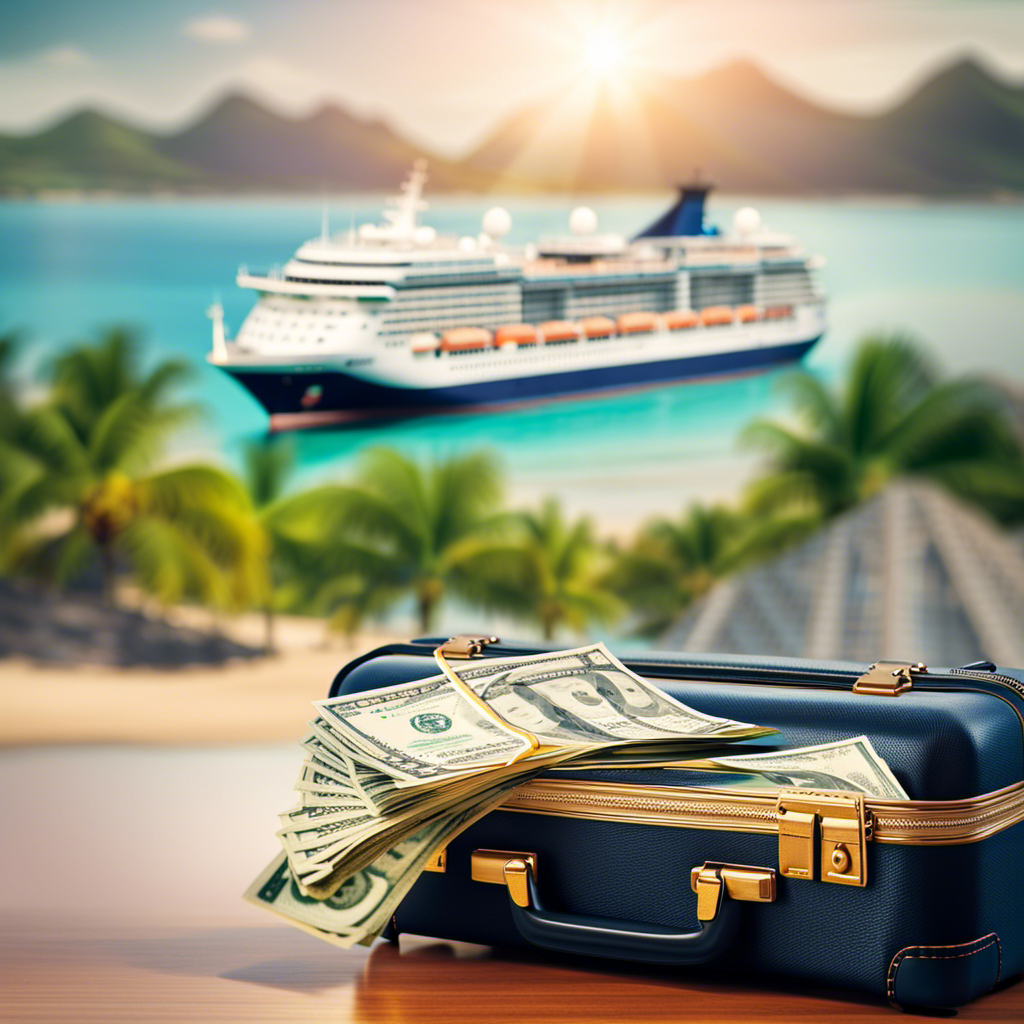Setting out on the journey to plan my perfect cruise, I find myself facing a crucial question: how much money should I set aside for savings? It’s like navigating uncharted waters, trying to map out the best route for my financial situation.
In this article, we will dive into the average cost of a cruise, the factors influencing its price, and practical tips for saving money along the way.
So, grab your compass and join me on this voyage to financial preparedness for an unforgettable cruise experience.
Key Takeaways
- The average cost of a cruise vacation ranges from $1,000 to $2,500 per person, depending on factors such as the length of the cruise, type of cabin, time of year, and cruise line choice.
- Factors affecting the cost of a cruise include seasonal price fluctuations, with peak travel seasons often leading to higher prices. The choice between all-inclusive and à la carte options also affects the overall cost, with all-inclusive packages providing convenience and cost-effectiveness, while à la carte options allow for more control over expenses.
- To save money on a cruise, it is recommended to book during the off-peak season, be flexible with departure dates and destinations, book well in advance or last minute, and research and compare different cruise lines and itineraries. Implementing saving strategies can also help reduce the cost of the cruise vacation.
- Hidden costs to consider for a cruise include unforeseen onboard expenses such as specialty dining, drinks, spa treatments, and gratuities. It is important to research and compare port excursion prices in advance to have a realistic understanding of the total cost of the cruise. Budgeting for gratuities and tipping is crucial, as failure to do so can lead to unexpected costs that can quickly add up and impact the overall cruise budget.
Average Cost of a Cruise Vacation
You’ll be glad to know that the average cost of a cruise vacation is around $1,000 to $2,500 per person. When budgeting for a cruise, it’s important to consider various factors that can affect the prices.
One of the main factors is the length of the cruise. Longer cruises tend to be more expensive due to the increased number of days at sea and ports of call.
Another factor is the type of cabin you choose. Interior cabins are usually the most affordable option, while suites can be significantly pricier.
Additionally, the time of year and the cruise line you choose can also impact the cost.
To budget for a cruise, it’s helpful to set a target price range, research different cruise lines and itineraries, and consider any additional expenses like gratuities, excursions, and onboard activities.
Now, let’s delve into the factors that affect the overall cost of a cruise.
Factors Affecting the Cost of a Cruise
When it comes to the cost of a cruise, two important factors to consider are seasonal price fluctuations and the choice between all-inclusive and à la carte options.
Seasonal price fluctuations can greatly impact the cost of a cruise, with peak travel seasons often leading to higher prices.
Additionally, the choice between all-inclusive and à la carte can also affect the overall cost. All-inclusive packages may include meals, drinks, and activities, while à la carte options require separate payments for each service.
Understanding these factors can help you make informed decisions when planning a cruise vacation and budgeting accordingly.
Seasonal Price Fluctuations
To take advantage of seasonal price fluctuations, it’s important to plan your cruise and budget accordingly. Seasonal discounts can significantly lower the cost of your cruise, while peak season pricing can make it more expensive. Here are some things to consider:
- Off-peak seasons often offer lower prices and fewer crowds, allowing you to save money and enjoy a more relaxed experience.
- Booking your cruise well in advance can help you secure the best deals and take advantage of early bird discounts.
- Consider traveling during shoulder seasons, which are the periods just before or after peak season, as prices may be lower during these times.
- Keep an eye out for last-minute deals, as cruise lines sometimes offer discounted rates to fill up empty cabins.
- Consider being flexible with your travel dates, as prices can vary depending on the day of the week or time of the month.
All-Inclusive Versus À La Carte
The main difference between all-inclusive and à la carte options is that with all-inclusive, you’ll have unlimited access to food and beverages, while with à la carte, you’ll pay for each item separately.
All-inclusive packages are a popular choice for many cruisers due to their convenience and cost-effectiveness. They provide a wide range of benefits, including access to multiple dining venues, unlimited drinks, and sometimes even additional perks like spa treatments or excursions.
On the other hand, à la carte options allow you to have more control over your expenses, as you only pay for what you consume. This can be a good option if you prefer to be more selective with your choices or if you have specific dietary requirements.
Ultimately, the decision between all-inclusive and à la carte will depend on your personal preferences and budget.
Speaking of budget, let’s now discuss setting a budget for your cruise, ensuring you have an enjoyable experience without breaking the bank.
Setting a Budget for Your Cruise
Determining cruise expenses is an essential step in setting a budget for your upcoming vacation. By carefully assessing the various costs involved, such as accommodation, transportation, meals, and excursions, you can make informed decisions about how much to allocate for each category.
Effective fund allocation is crucial to ensure that you have enough money for all aspects of your cruise while also being mindful of your overall budget. Additionally, saving for cruise costs ahead of time can help you avoid financial stress and allow for a more enjoyable experience knowing that you have funds set aside specifically for this purpose.
Determining Cruise Expenses
It’s important to factor in all potential cruise expenses before setting a savings goal. When planning for a cruise, it’s crucial to consider the average daily expenses that you may incur.
These expenses include meals, drinks, entertainment, shore excursions, and gratuities. Budgeting strategies can help you estimate these costs and allocate funds accordingly.
Start by researching the cruise line and ship you plan to sail on, as each may have different pricing structures. Take into account any additional expenses such as transportation to the departure port, travel insurance, and pre- or post-cruise accommodations.
Allocating Funds Effectively
Now that we have a clear idea of the expenses involved in a cruise, it’s essential to allocate our funds effectively in order to save for this exciting vacation.
Allocating funds simply means dividing our income into different categories and setting aside a portion specifically for our cruise savings. One effective strategy is to create a budget where we track our expenses and identify areas where we can cut back. For example, we can reduce unnecessary spending on dining out or entertainment and redirect those funds towards our cruise savings.
Another strategy is to automate our savings by setting up automatic transfers from our paycheck or checking account into a separate cruise savings account. This way, we won’t even have to think about saving; it will happen automatically.
By implementing these saving strategies, we can steadily build up our cruise fund without feeling overwhelmed.
Now, let’s dive into some specific ways to save for cruise costs.
Saving for Cruise Costs
To effectively save for the costs of your upcoming cruise, you can start by analyzing your monthly expenses and identifying areas where you can cut back on unnecessary spending. This will help you allocate more funds towards your cruise savings.
Here are three factors that can affect your savings and strategies for effective saving:
-
Budgeting: Creating a budget and sticking to it is crucial for saving money. By tracking your expenses and setting limits on discretionary spending, you can free up more money for your cruise fund.
-
Minimizing Debt: High-interest debt can eat into your savings. Paying off credit cards and loans before your cruise will save you money in interest charges and allow you to put more towards your vacation.
-
Automating Savings: Set up automatic transfers from your checking account to a separate savings account specifically for your cruise. This way, you won’t have to rely on willpower alone to save, and the money will grow without you even noticing.
By implementing these strategies, you can build a substantial amount of savings for your dream cruise.
Now, let’s move on to some tips for saving money on a cruise.
Tips for Saving Money on a Cruise
One way to save money on a cruise is by booking during the off-peak season. This is one of the most effective saving strategies for budgeting tips. By avoiding peak travel times, such as school holidays or popular vacation months, you can often find significant discounts on cruise fares.
Additionally, consider being flexible with your departure dates and destinations. Sometimes, choosing a less popular itinerary or sailing during weekdays can result in lower prices.
Another money-saving tip is to book your cruise well in advance or last minute. Booking early allows you to take advantage of early bird discounts, while last-minute deals can offer substantial savings.
Don’t forget to research and compare different cruise lines and itineraries to find the best value for your money. By implementing these saving strategies, you can significantly reduce the cost of your cruise vacation.
Now, let’s explore the hidden costs to consider for your cruise.
Hidden Costs to Consider for Your Cruise
When planning a cruise, it’s essential to consider the potential unforeseen onboard expenses and port excursion prices. These hidden costs can quickly add up and impact your overall budget.
From specialty dining and drinks to spa treatments and gratuities, it’s crucial to factor in these additional expenses to ensure you have a realistic understanding of the total cost of your cruise.
Additionally, researching and comparing port excursion prices in advance can help you make informed decisions and avoid any surprises when it comes to the cost of exploring various destinations.
Unforeseen Onboard Expenses
Be aware of the unforeseen onboard expenses that can add up during a cruise. While you may have accounted for the cost of your ticket and accommodation, there are hidden fees and unexpected charges that can catch you off guard. To help you prepare, here is a breakdown of potential onboard expenses:
| Onboard Expenses | Average Cost | Tips to Save |
|---|---|---|
| Specialty Dining | $30 – $50 per meal | Opt for included dining options or book dining packages in advance |
| Drinks Package | $50 – $100 per day | Consider purchasing a package that suits your drinking habits |
| Shore Excursions | $75 – $200 per excursion | Research and book independently for potential savings |
Port Excursion Prices
Make sure to research and compare prices for port excursions before booking, as this can help you find the best deals and maximize your experience. When it comes to port excursion planning, here are five important things to consider:
-
Check the cruise line’s offerings: Many cruise lines offer their own excursions, which can be convenient but may also be more expensive. Take a look at what they have to offer and compare prices with independent tour operators.
-
Look for local operators: Sometimes, booking directly with local tour operators can save you money compared to the cruise line’s prices. Plus, you may get a more authentic and personalized experience.
-
Read reviews: Before booking any excursion, read reviews from other travelers to get an idea of the quality and value for money.
-
Consider group discounts: If you’re traveling with a group, check if there are any group discounts available for certain excursions.
-
Be mindful of timing: Excursions booked through the cruise line often have a strict schedule. If you want more flexibility and potentially lower prices, consider booking independently.
By comparing excursion prices and taking these factors into account, you can make informed decisions and save money on your port adventures.
Speaking of saving money, let’s move on to the next section about how to calculate the total cost of a cruise.
How to Calculate the Total Cost of a Cruise
Calculating the total cost of a cruise can be done by adding up the expenses for transportation, accommodation, meals, and activities. To get an average cost calculation, it’s important to consider the duration of the cruise and the type of cabin you choose.
Budgeting strategies can help you plan ahead and avoid overspending. Start by researching different cruise lines and comparing prices. Look for deals and discounts, especially during off-peak seasons. Don’t forget to factor in additional costs such as gratuities, taxes, and port fees. It’s also a good idea to set aside some money for souvenirs and any optional excursions you might want to take.
By carefully considering all these aspects, you can estimate the total cost of your cruise and ensure you have enough funds to enjoy your vacation without any financial worries.
Now, let’s move on to planning for extra expenses during your cruise.
Planning for Extra Expenses During Your Cruise
When planning for your cruise, don’t forget to factor in additional expenses such as spa treatments and specialty dining. It’s easy to get caught up in the excitement of booking your dream vacation and overlook these extra costs. However, it’s important to plan for unplanned expenses to avoid any financial surprises during your trip.
Managing onboard expenses is crucial to staying within your budget. One strategy is to set aside a separate budget specifically for these additional expenses. This way, you can enjoy the extra amenities without worrying about overspending.
Another tip is to research and compare prices for spa treatments and specialty dining options before your cruise. By doing so, you can find the best deals and potentially save some money.
Transitioning into strategies for saving money before your cruise, let’s explore some ways to cut costs and make your dream vacation more affordable.
Strategies for Saving Money Before Your Cruise
Before you set sail, don’t forget to take advantage of discounts and promotions offered by the cruise line to help you cut costs and make your dream vacation more affordable. Here are some saving strategies and budgeting tips to consider:
-
Research and compare prices: Look for the best deals by comparing prices across different cruise lines and travel agencies. Don’t forget to check for any special offers or discounts that may be available.
-
Book in advance: By booking your cruise early, you may be able to secure lower prices and take advantage of early booking incentives.
-
Be flexible with your travel dates: Consider traveling during the off-peak season or on weekdays, as prices tend to be lower during these times.
-
Pack wisely: Avoid unnecessary expenses by packing essentials such as toiletries and medications. Also, bring your own reusable water bottle to save on drink costs onboard.
How Much to Save for Onboard Activities and Excursions
After saving money for your cruise and booking your dream vacation, it’s important to consider how much to save for onboard activities and excursions. These additional expenses can vary depending on your personal preferences and the cruise line you choose. To help you plan and budget, here’s a breakdown of common onboard expenses:
| Onboard Dining Options | Entertainment Expenses |
|---|---|
| Specialty Restaurants | Spa Treatments |
| Beverage Packages | Casino Gambling |
| Room Service | Shows and Performances |
| Specialty Coffee | Onboard Shopping |
Keep in mind that these costs can add up quickly, so it’s essential to factor them into your overall budget. Consider researching the prices of specific activities and excursions in advance to get an idea of how much you’ll need to save. By planning ahead and being mindful of your spending, you can enjoy all the onboard amenities without breaking the bank.
Now, let’s move on to budgeting for gratuities and tipping on a cruise.
Budgeting for Gratuities and Tipping on a Cruise
To ensure a smooth sailing experience, don’t forget to factor in gratuities and tipping when budgeting for your cruise. It’s important to plan ahead and allocate funds for these expenses, as they can add up quickly.
Here are some tips for budgeting for onboard dining and managing tipping expenses:
-
Understand the tipping policies: Familiarize yourself with the cruise line’s tipping guidelines. Some cruise lines automatically charge a daily gratuity fee, while others leave it up to the discretion of the passengers.
-
Plan for specialty dining: If you’re planning to dine at specialty restaurants onboard, remember to include the additional cost in your budget. These restaurants often require an extra fee or have a higher gratuity expectation.
-
Consider prepaid tipping options: Some cruise lines offer the option to prepay gratuities when booking your cruise. This can help you manage your expenses and avoid any surprises at the end of your trip.
Frequently Asked Questions
Are There Any Additional Costs for Dining Options on a Cruise?
There may be additional costs for specialty dining options on a cruise. It’s important to check the cruise line’s website or contact them directly to find out about any hidden charges for room service.
How Much Should I Budget for Alcoholic Beverages on a Cruise?
When budgeting for a cruise, it’s important to consider the cost of alcoholic beverages. To save money, I recommend setting a daily limit and taking advantage of drink packages or happy hour specials.
Are There Any Fees or Charges for Using Onboard Amenities Like the Gym or Spa?
There are fees for using onboard amenities like the gym or spa. The cost of spa services can vary depending on the cruise line and the specific treatment. It’s important to budget for these additional expenses when saving for a cruise.
How Much Money Should I Set Aside for Souvenirs or Shopping During the Cruise?
When it comes to budgeting for a cruise, it’s important to consider how much money to set aside for souvenirs or shopping. Here are some tips on the best ways to save money in this area.
Is Travel Insurance Included in the Cost of a Cruise, or Is It an Additional Expense?
Travel insurance for a cruise is usually an additional expense. It’s important to compare different plans to find the right coverage for your needs. Consider the benefits and costs to ensure you’re adequately protected.
Conclusion
In conclusion, saving for a cruise can be a daunting task, but it is definitely achievable with careful planning and budgeting. By considering factors such as the average cost of a cruise, hidden expenses, and strategies for saving money, you can sail away on your dream vacation without breaking the bank.
Just like a captain navigating through rough waters, you too can steer your finances in the right direction and make your cruise dreams a reality. So, start saving today and get ready to set sail on an unforgettable adventure.










